#jackson pollock autumn rhythm
Explore tagged Tumblr posts
Text

Jackson Pollack - #7 AUTUMN RHYTHM (NUMBER 30), 1950
1950 was a golden year for Jackson Pollock. It was a time where he was at his artistic best and had mastered the drip technique. Surprisingly he abandoned the drip style the following year. Autumn Rhythm, which was originally titled Number 30, is one of his several masterpieces of the drip period. The painting consists of chaotic black, white and brown paint patterns and is known for having no focal point thus rendering every bit equally significant.
#jackson pollock#art#art nouveau#artistic#artist#artwork#art aesthetic#art academia#autumn#1950#1950s
80 notes
·
View notes
Text

+++++++++++++++++Jackson Pollock
AUTUMN RHYTHM, 1950
1950 was a golden year for Jackson Pollock. It was a time where he was at his artistic best and had mastered the drip technique. Surprisingly he abandoned the drip style the following year. Autumn Rhythm, which was originally titled Number 30, is one of his several masterpieces of the drip period. The painting consists of chaotic black, white and brown paint patterns and is known for having no focal point thus rendering every bit equally significant.
0 notes
Text
Writing & Research

Hi, my name is Kristin and one fact about me is that I have a passion for color guard, and currently spin with the USF Herd of Thunder Color Guard and USF Winter Guard World team.
I was assigned #3 Jackson Pollock 1950 Autumn Rhythm (Number 30). Enamel on canvas; 105” x 207”.
Five Facts:
Pollock worked with the canvas flat on the floor, constantly moving around all four sides to apply paint.
Jackson Pollock created his first "drip" painting in 1947, and just 3 years later he created "Autumn Rhythm" in 1950.
Even though there is much thought to an abstract painting such as this, Pollock said there is no accident and that he controls the paint.
Within "Autumn Rhythm" there is no central focus an no hierarchy of elements, every piece of the canvas is important.
The size of the artwork is significant since it is 207 inches wide and it assumes the scale of the environment for both the artist and the viewers.
Overall, I believe that the way I think when I view "Autumn Rhythm" is different from the first time I viewed it due to the meaning of the painting to the artist. My first initial thought resembled that of "Wow that sure is one abstract piece of art." However, now looking at this piece I have a slightly different view to it, in which I see Pollocks view of self-discovery and state of being. Within the art itself I was able to view the different aspects of the strokes and paint swirls created in what I now know were quite unorthodox ways for the time, as well as realize the significance within all of the swirls and swooshes of the paint.
1 note
·
View note
Text
Jackson Pollock


Links to Images:
One: Number 31, 1950: https://uploads4.wikiart.org/images/jackson-pollock/one-number-31-1950.jpg
Autumn Rhythm (Number 30): https://upload.wikimedia.org/wikipedia/en/f/fa/Autumn_Rhythm.jpg
Jackson Pollock was an American Painter. Although dying young at the age of 44 in a car crash, Pollock created a substantial body of work, known mostly for his signature “Drip Technique”, which has become iconic within the abstract expressionist genre, of which he was a founder. Thoughts on Pollock’s work is heavily divided, some saying it’s nonsense and unskilled. It is undeniable the impact that Jackson Pollock’s work has made on the art work, one that is still being felt today.
Pollock painted in a very physical way, often with the large canvas on the floor, spilling, throwing and splashing paint while walking around it’s perimeter. This expressive and unique style created thick layers of paint, appearing in seemingly random marks and splashes, although actually showed Pollock’s control and understanding of his medium as it flowed, so much so that it brought him to the height of fame in his career.
I think that keeping in mind Jackson Pollock’s style and method of painting would be a good way to explore further the pendulum that we used in the workshop, as similarly both are very physical in their movements, and create a variety of expressive marks.
1 note
·
View note
Link
0 notes
Text
Virtual Sketchbook #1
1.) Five facts about Jackson Pollock and his work Autumn Rhythm No 30:
Jackson Pollock made his first “drip” or “action painting” in 1947, where he lays the canvas on the floor and used multiple methods of applying paint including drips, splatters, and brushworks from above.
Another one of Pollock’s paintings (No. 5, 1948) became the world’s most expensive painting of that time selling in May of 2006 for 140 million dollars.
Pollock had a movie Oscar winning movie made about him titled, “Pollock”.
Autumn Rhythm No. 30 was bought for $20,000 from Pollock’s estate following his untimely death at the age of 44 in 1956.
Autumn Rhythm No. 30 is currently at the Metropolitan Museum of Art.
My first thoughts when looking at Autumn Rhythm was that it seemed chaotic and a little overwhelming. Having little exposure in art and not fully comprehending intentions when it comes to abstract work, I felt like I wasn’t understanding what the artist was trying to convey. But the more I looked at it, I began to see the flow and movement in the patterns of paint. After researching the art piece and its creator, Jackson Pollock, I have come to learn that what I first saw as chaos is the opposite. Pollock purposefully and intentionally made each stroke, splatter, and drip the way that he wanted, making the abstract painting a uniquely beautiful piece or artwork.
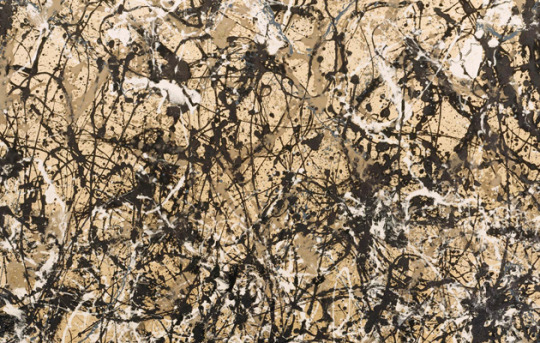
Autumn Rhythm (No. 30) Jackson Pollock
2.) This is from a picture from a coloring book my mom finished while she was receiving treatment at Moffitt Cancer Center. She had just undergone a bone marrow transplant that required a very potent dose of chemo that left her unable to talk, walk, stand or do much else. She was, however, able to create the picture. She was fighting for her life and was still able to put bright, hopeful colors into it. This was an incredibly difficult time for my family and despite the odds, my mom pulled through and beat leukemia. I have this up in my room as a reminder of the strength it took to get through that time and to always try to look on the bright side.
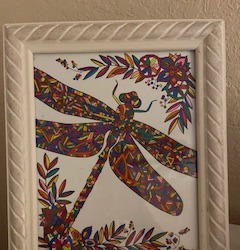
3.) My name is Mary. I am a 29-year-old Caucasian female (recently turned 29, 30 is still aways away 😊). I am from Fort Wayne, Indiana. My family used to vacation in Siesta Key and always dreamed of living in Florida. We finally were able to move to North Port in 2018. My favorite thing to do when I don’t have much going on is puzzles. My friends call me an old lady because I would rather stay in doing puzzles than go out most times. I have been a bartender/server since I was 19, which is long enough. I am very ready to finish college and begin on a new career path. A unique part of me is that I aspired to be a professional photographer, specializing in landscapes, architecture, and animals. My original major at SCF was Digital Photography, but after I became pregnant with my first child in 2022, I decided to switch to a more stable profession in the medical field. I hope taking Art Appreciation will allow me to learn more about my creative side and I can continue pursue photography as a hobby.
4.)

1 note
·
View note
Text
youtube
Artist: Jackson Pollock
Artwork: "Autumn Rhythm (Number 30)" (1950)
Style: Abstract Expressionism

Pollock is daring, unconventional, dynamic, curious, and unique. The absence of recognizable objects or figures in most of his art allows for a wide range of interpretations, making it more inclusive and open to individual experiences. Let's dive into the modern art at MoMA.
0 notes
Text
1. Introductions/First Artworks

Hello, classmates! My name is A*** R*******. I’m returning to school after focusing on work for the past few years to become a mechanical engineer. A little know fact about me is that I’ve recently taken up blacksmithing as a hobby. I don’t know what inspired me to do so, but it’s quickly becoming my favorite creative outlet.
5 Facts about Jackson Pollock’s Autumn Rhythm (Number 30):
Autumn Rhythm (Number 30) was painted in 1950 in the abstract expressionist art style that Jackson Pollock was known for and is considered one of his most notable works.
Pollock painted this piece using the “drip technique”, in which he drizzled, splashed, and poured enamel paint across a large unprimed canvas that was laid on the floor.
The painting was created in the Fall of 1950 at his studio in Springs, New York and was first exhibited at the Betty Parsons Gallery from November to December 1951.
The size of the painting is impressively over 17 feet wide. Pollock took full advantage of the large size by painting from all sides of the canvas.
The Autumn Rhythm was purchased in 1957 from the artist’s estate for $20,000 by the New York Metropolitan Museum of Art, where it still resides today.
I’m not a huge fan of abstract works of art, but after taking a deeper look into what went into making Autumn Rhythm, I appreciate it much more. The haphazard style of the painting made me initially skeptical as to how this could be seen as a masterpiece until I saw a video analyzing it on the Metropolitan Museum of Art website. What captured my attention is just how large the actual painting is and all the details that I missed as a result. The areas of the canvas that were saturated with paint, the overlapping lines, and the contrast of the colors grew in appeal the longer I stared at them. Almost like I was trying to find something hiding behind them. As such, I can now see a more purposeful piece of art as opposed to a nonsensical composition.
1 note
·
View note
Text

Jackson Pollock: Expresionismo Abstracto
La película “Pollock”, dirigida y protagonizada por Ed Harris, es un profundo vistazo a la vida y obra del icónico pintor Jackson Pollock. La cinta nos sumerge en la mente del artista, mostrándonos su lucha interna y su búsqueda incansable de expresión a través de la pintura. Al igual que el expresionismo abstracto, Pollock desafió las convenciones artísticas tradicionales al adoptar una técnica de goteo y salpicado que buscaba transmitir emociones profundas y caóticas.
El expresionismo abstracto como movimiento artístico se caracteriza por su rechazo de la representación figurativa en favor de la expresión pura y la experimentación con la forma y el color. En este contexto, la obra de Pollock se destaca como un ejemplo extraordinario de cómo el arte puede ser una expresión visceral de las emociones humanas. Sus pinturas, como “Autumn Rhythm” y “Number 1A, 1948”, evocan una sensación de energía y caos controlado que invita al espectador a reflexionar sobre su propio mundo interior.
El Centro Pompidou en París, por su parte, desempeña un papel importante en la promoción y exhibición de arte moderno y contemporáneo, incluyendo obras de expresionistas abstractos como Pollock. Como uno de los principales museos de arte contemporáneo del mundo, el Centro Pompidou ha sido un faro de innovación artística y un lugar donde se pueden apreciar las obras que desafían las normas convencionales.
“Pollock” y el expresionismo abstracto nos recuerdan que el arte es una forma poderosa de expresión emocional y una herramienta para romper barreras creativas. El Centro Pompidou, como defensor del arte contemporáneo, sigue siendo un faro de inspiración para aquellos que buscan explorar las fronteras del arte y la expresión.
0 notes
Text
Autumnal Melancholy
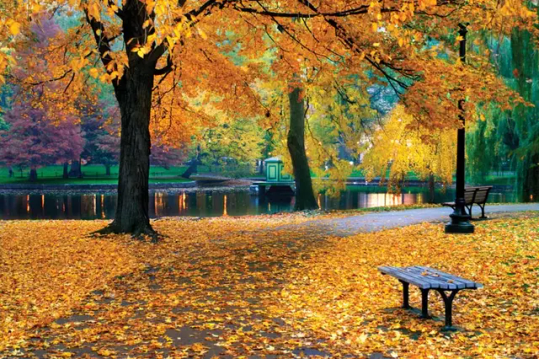
As autumn unfurls its vibrant tapestry of reds, oranges, and browns, it often evokes a sense of melancholy. The leaves fall like russet tears, marking the transition from the lushness of summer to the stillness of winter. This season, rich in symbolism, is a recurring motif in art and literature, representing transition, decay, and loss. Autumn forces us to confront the inevitability of change, reminding us that we are but a small part of the greater natural world and to bear witness to the death that follows the vibrant life of spring. While we may now associate this season with cosy sweaters, hot drinks, and crackling fires, its underlying melancholy lingers in the crisp air, serving as a memento mori. For those grappling with their own grief and loss, autumn poses unique challenges, compelling us to seek solace in a world that forces us to confront these harsh realities.

In literature, autumn is frequently portrayed as the twilight of the year, a liminal space between the vitality of spring and the bitter winter cold. Notably, this is illustrated in W.B. Yeats’ poem, The Wild Swans at Coole. He pairs the image of the trees’ ‘autumn beauty’ with the ‘twilight’ setting to demonstrate this cyclical and transient nature of life, imbuing the scene with a sense of stasis, reflection, and tranquility as the speaker contemplates ephemeral human existence with the ineffable immortality of nature. This evokes a part of grief that I had never considered before I had experienced it: our loved ones who pass away are frozen in time like a pressed flower, never to bloom again in the spring, while we are meant to continue to grow. At first, I felt indignant and outraged at the unfairness of it all. How am I supposed to continue without them? How can the world keep turning or the seasons keep changing without our departed loved ones here to witness it?
As someone who has a history of mental illness, it feels cruel that someone so precious, beautiful, and ready for life should be taken away so soon. A bright light was extinguished. Whereas someone like me, flickering and dim, continues to burn. It's not fair. I've always known it's not fair; the guilt tastes like ash in my mouth. Throughout Yeats’ poem, the speaker focuses on these swans’ stasis throughout the years despite this change. They remain a collective mass that implies a monolithic unity, creating an illusion of immortality. This image is a microcosm of the enduring vitality of nature. We, too, will one day enter the winter of our lives, fall to the ground, and bring new life to the soil, much like autumn leaves. It comforts me to apply the permanence of the swans to ourselves. Through the lens of Yeats’ poem, we can interpret this season as a reminder of the human condition, not just as individuals who cannot be resurrected and become lost to the ravages of time, but as integral parts of the regenerative whole of nature, forming a larger community that creates new life as it witnesses death.

Another one of my favourite expressions of autumn is found in Jackson Pollock's Autumn Rhythm (Number 30, 1950). He employs a dripping technique in which paint is splattered, flung, and pooled onto the canvas to create an expressionist, non-representative explosion. The arches, curves, overlapping colours, and frenetic peaks of colour vividly illustrate the boundless nature of existence, its continuous flow without a clear beginning or end. Both the melancholic atmosphere conveyed by the dark colours and the chaos of this tempestuous expression reflects an internal turmoil and emotional turbulence, as well as the larger mutability of nature . The all-consuming contrast between the black and white paint conveys a liminality, changeability, and duality within autumn - the bountiful harvests and the withering trees, the transition from summer to winter. The lack of typical autumnal imagery is striking as Pollock encapsulates a visceral feeling, a power beyond the individual, he illustrates the greater cycle of life just like Yeats’ swans.
There’s a promise of change that lies beyond autumnal decay, one that promises more than ornate carpets of leaves and petals of breath that bloom in the air. The words of F. Scott Fitzgerald come to mind: "Life starts all over again when it gets crisp in the fall.” Perhaps in this lies a possible comfort to find in this autumn. It serves as a poignant reminder of our place within the vast universe.
#thoughts#words#spilled words#autumn#artwork#writers on tumblr#writing#analysis#melanchaholic#mental illness#fall#autumn aesthetic#fall aesthetic#loss#grief#existence#existentialism#word web#web weaving
0 notes
Text
Autumnal Melancholy
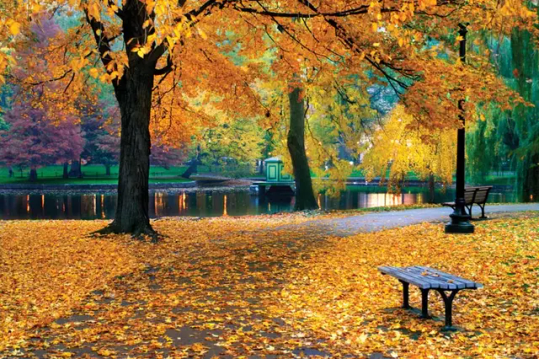
As autumn unfurls its vibrant tapestry of reds, oranges, and browns, it often evokes a sense of melancholy. The leaves fall like russet tears, marking the transition from the lushness of summer to the stillness of winter. This season, rich in symbolism, is a recurring motif in art and literature, representing transition, decay, and loss. Autumn forces us to confront the inevitability of change, reminding us that we are but a small part of the greater natural world and to bear witness to the death that follows the vibrant life of spring. While we may now associate this season with cosy sweaters, hot drinks, and crackling fires, its underlying melancholy lingers in the crisp air, serving as a memento mori. For those grappling with their own grief and loss, autumn poses unique challenges, compelling us to seek solace in a world that forces us to confront these harsh realities.

In literature, autumn is frequently portrayed as the twilight of the year, a liminal space between the vitality of spring and the bitter winter cold. Notably, this is illustrated in W.B. Yeats’ poem, The Wild Swans at Coole. He pairs the image of the trees’ ‘autumn beauty’ with the ‘twilight’ setting to demonstrate this cyclical and transient nature of life, imbuing the scene with a sense of stasis, reflection, and tranquility as the speaker contemplates ephemeral human existence with the ineffable immortality of nature. This evokes a part of grief that I had never considered before I had experienced it: our loved ones who pass away are frozen in time like a pressed flower, never to bloom again in the spring, while we are meant to continue to grow. At first, I felt indignant and outraged at the unfairness of it all. How am I supposed to continue without them? How can the world keep turning or the seasons keep changing without our departed loved ones here to witness it?
As someone who has a history of mental illness, it feels cruel that someone so precious, beautiful, and ready for life should be taken away so soon. A bright light was extinguished. Whereas someone like me, flickering and dim, continues to burn. It's not fair. I've always known it's not fair; the guilt tastes like ash in my mouth. Throughout Yeats’ poem, the speaker focuses on these swans’ stasis throughout the years despite this change. They remain a collective mass that implies a monolithic unity, creating an illusion of immortality. This image is a microcosm of the enduring vitality of nature. We, too, will one day enter the winter of our lives, fall to the ground, and bring new life to the soil, much like autumn leaves. It comforts me to apply the permanence of the swans to ourselves. Through the lens of Yeats’ poem, we can interpret this season as a reminder of the human condition, not just as individuals who cannot be resurrected and become lost to the ravages of time, but as integral parts of the regenerative whole of nature, forming a larger community that creates new life as it witnesses death.
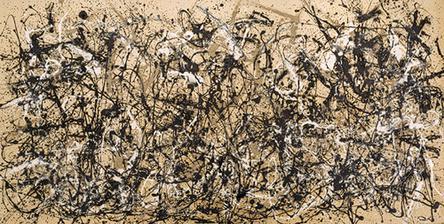
Another one of my favourite expressions of autumn is found in Jackson Pollock's Autumn Rhythm (Number 30, 1950). He employs a dripping technique in which paint is splattered, flung, and pooled onto the canvas to create an expressionist, non-representative explosion. The arches, curves, overlapping colours, and frenetic peaks of colour vividly illustrate the boundless nature of existence, its continuous flow without a clear beginning or end. Both the melancholic atmosphere conveyed by the dark colours and the chaos of this tempestuous expression reflects an internal turmoil and emotional turbulence, as well as the larger mutability of nature . The all-consuming contrast between the black and white paint conveys a liminality, changeability, and duality within autumn - the bountiful harvests and the withering trees, the transition from summer to winter. The lack of typical autumnal imagery is striking as Pollock encapsulates a visceral feeling, a power beyond the individual, he illustrates the greater cycle of life just like Yeats’ swans.
There’s a promise of change that lies beyond autumnal decay, one that promises more than ornate carpets of leaves and petals of breath that bloom in the air. The words of F. Scott Fitzgerald come to mind: "Life starts all over again when it gets crisp in the fall.” Perhaps in this lies a possible comfort to find in this autumn. It serves as a poignant reminder of our place within the vast universe.
#writing#autumn#fall aesthetic#writerblr#melanchonic#web weaving#spilled words#essay#mental illness#grief#loss#fall
1 note
·
View note
Text
Autumn Rhythm

Jackson Pollock 1950 Autumn Rhythm (Number 30). Enamel on Canvas; 105” x 207”.
I was originally perplexed by the artwork above, but I also I felt curious and wanted to learn more.
Five Facts about Jackson Pollock
Pollock struggled with alcoholism for most of his life, which led to his death at the young age of 44 in a car accident.
When making Autumn Rhythm, he placed the canvas on the floor and would move himself around as he worked on each of the four sides.
In the 44 years he lived, he created 363 paintings.
He was deemed medically unfit to serve in the war.
Pollock switched from naming his paintings to numbering them because he didn't like that the names offered viewers something to look for.
My initial reaction to Autumn Rhythm wasn’t all that impressed because I immediately looked at it and thought how simple the work is compared to other artworks during this time. That immediately changed, though, when I took the time to examine it much further and consider it on a deeper level, setting aside my initial reaction. I couldn't help but note how the colors he selected—white, browns, and blacks—all work incredibly well and complement one another. Moving on, I don't think he intended for you to find something in his work but rather wanted to convey an emotion when you see it, and I believe he succeeded on that. Since I know he struggled with alcoholism, when I look at this work and learn of his struggles, I instantly feel empathy because I imagine his mind felt disorganized like this painting.
1 note
·
View note
Text

(Virtual Sketchbook #1)
Greeting, my name is Ryan Nguyen and one of little known fact about myself is that the last time I ever travel to outside of Florida nearly 5 years ago is Los Angeles from California which lasted 2 months of fun experience during the summer trip with my family members and friends.
Autumn Rhythm by Jackson Pollock
The work of Autumn Rhythm serves it causes to summon up a sensation of otherworldly intensity which are continuously advancing in the absence of dawn or dusk.
Jackson Pollock is best skillful for his measures of portrays and the works of Abstract Expressionist. For these projects, many have created during his stream time, Pollock splash paint onto canvas to depict the feeling in response of motion. He then encountered subjects as well as bizarre map-reading of the insentient and Jungian exemplifies.
Some techniques of Pollock which come from the uses of ladle, sticks, and cutters to make up entanglements of slash line and various colors, sculpting murky webs and grids that the covering on top of one another to put forward signs of development and room.
Pollock's works are very pursued after for their brilliance, inspiration on the Abstract Expressionist movement, and as a illustration of Americanism. Among his costly sculpted pieces, including Blue Poles, which is priced up to approximately $350 million, and sold for $200 million which make the work of its painting so precious and treasures.
Jackson Pollock's favorite hobby in ceramics was influenced along with the task of his mentor, Thomas Hart Benton, who come across competent in the course of his penniless times in New York that it was serene and undisturbed to exchange furnished ceramics for sales rather than paintings which appears to pull through twice miraculously.
At first, I thought the painting of the piece from Autumn Rhythm was all randomly messy and splattered, with lines and color swirling all over the inserted frame. But after upon further investigation, the art of its work show such sprinted visual rhythm which gives off very bodily notation of connecting the painting with the artist's recent techniques.
------------------------------------------------------------------------------

The work of art shows labor tasks all men, including women and children, have to go through. Some medias include pen, ink, and acrylic paints. The art serves to appraise regular people in a realistic attitude when participate in every day's works which seems burden.
I'm recently become 20 years old since last month. My gender is male. The country I was born from are Vietnam. My ethnicity is Asian. Some hobbies or types of fun I usually do during my break time is sketching or drawing unfinished digital arts on phone or iPad, planning and listing things on white board for any kind of arrangement, and watching news from twitter, Youtube, and other social networks. Currently, I'm not assigned to any particular group or organization. I'm in a process of completing the course requirements for Associate in Arts degree from online college. What makes me unique is that I'm the tallest family members than the rest of my family, including my older sibling and grandfather.

This type of self-portrait I come up with depicts the kind of freedom I have looking for once I'm cleared all the remaining assignments and tasks that has still yet come before me. But no matter how much I accomplished, there's still more endless possibilities that I still has yet to overcome. The more I think about it, the more worry it grow within my mind, but it also somewhat give me courage and motivation to keep thriving to avoid failing again after countless mistakes I made in life along the way.
1 note
·
View note
Text
Virtual Sketchbook #1

"Jackson Pollock 1950 Autumn Rhythm (Number 30). Enamel on canvas; 105” x 207”.Some facts about Image #3 and Jackson Pollock"
It is believed to be valued at upwards of $140 million
Very large size at 4 by 8 feet and Pollock would splash paint onto the canvas using things like brushes, syringes and knives
Jackson Pollock used upholsterer's canvas because painter's canvas was too pricey for him
He was expelled from high school twice for being "rebellious"
Pollock died at 44 after crashing a car while drunk driving
Initially it reminded me of a cookie or maybe a Pop Tart with some icing on it; after looking at the image longer I now notice another color of paint that is not black or white. It now reminds me more of granite counter tops. I think of it different now that I learned that it is extremely valuable despite it's materials that were chosen specifically for their low cost. On top of that it makes me feel like its overpraised for the amount of effort that was put into making it.
Art and Writing

It is a black and white closeup photograph of a rhino printed onto canvas. It is for decoration and not really for any educational purpose because the angle doesn't show the rhino's proportions well and it only shows a small part of the entire rhino. I don't really think it is beautiful, there's even a little dirt on the horns. I more so think that it gives off a rugged and enduring look, the horns are dirty, the eyes are open, and it seems old with it's many wrinkles. The black and white aspect reminds me of rocks kind of fitting with the theme as well.
Self Portrait
I am a 20 year old male who moved from Chicago and has lived in Florida for most my life. My mom is Polish and my dad is Mexican. I like to go fishing, hang out with friends, work out, and play playstation. Im not in any groups but I used to be in track and XC at my high school. I work for an accountant and do bookkeeping. I feel like I am a forgiving person and have decent guidance but lack the motivation.
Art Project

For my first piece of art I drew myself walking through sand dunes to reach the homes of my family and I. I feel like this picture represents me because it shows that I am on a journey and I know where I want to be. Specifically, the journey represents me going to college and working for my future self even though I am not really benefiting from it in the moment. I hope to one day have the freedom to explore the world and start my own family but only after I have completed my journey.
I started with the first dune in the Apple Freeform app on my iPad and used a stylus. The app began to freeze and crash constantly but I wanted to keep using the same pen type so i continued using Freeform until i was done with the dunes and the sky. It must have crashed over 50 times. I decided to switch to the Adobe Fresco app afterwards which did not crash once.
1 note
·
View note
Text
Artistic Range
After reviewing all of my posts, I have noticed that I had a lot of different art pieces presented and analyzed. None of them are similar art pieces, but as I was researching, they all had something to do with nature, different meanings of them. The first post I have analyzed is a painting made by Claude Monet called, The Garden Painting. It is a river with some lily pads, some pink flowers on them, and some vines hanging on top. It is a calm piece, a look at nature in its natural state, since it is impressionism, nothing was planned. The second post was an analysis on a painting made by Nabil Nahas called, Tink Tonk. This is a completely different style of art compared to Claude Monet, it is full of different colors and shapes. It is a very bright painting, very energetic, it reminds me of Mario Kart when you race on the rainbow track. The final post was yet another analysis on a painting made by Jackson Pollock called, Autumn Rhythm. This one is kind of in between the first two posts, not too calm but also not as energetic as the second one. The colors are more neutral, and the painting is nothing specific, just what the artist was feeling. Liking different art styles shows range, there could be a specific location for certain paintings or color schemes when decorating. Art pieces can come in so many different styles that it is difficult to not want to admire different artists. Each of the posts had a different story, each artist is good at certain kinds of paintings, it takes time to complete them.
The Garden painting made by Claude Monet is an impressionist painting, he was actually the founder of impressionism. It mainly focuses on the outdoors and painting in the moment rather than in a studio. Nature has so many beautiful points that you can paint on the spot, this specific painting the lily pads is straight from a river, you can even see the detail of the moving water. The vines hanging on top are from trees, so he was most likely under them right next to the flowers, there were many different lily pads with different kinds of flowers. If you were decorating a house made in a more rural area or you like the style of impressionism, this would be a wise choice. The Tink Tonk painting made by Nabil Nahas, he was interested in modern art and Islamic paintings. He refers to the painting as the geometry of nature, the point is to see the reiteration of color, contrast, and abstraction for his vision. Nahas actually mixed different substances like pumice, volcanic rock, and different powders to create the painting as a whole and to make it look like a labyrinth. There are many different hues and shapes that makes it seem energetic and full of life, like nature itself. The painting called Autumn Rhythm made by Jackson Pollock is probably one of my favorites, it is a piece of art used in todays modern homes. This is actually considered a drip painting, if you look at it closely, you can see the "drips" throughout and it has different textures. I have a similar painting in my house and when you touch it, there are some textures that are smooth, some parts are more lifted and you feel the difference all throughout. Pollock described the painting as natures constant flux and a description of October (Autmn), which makes sense because the painting changes so much throughout just like nature. This painting was made in the 50s and till this day is still considered modern art and enlightened other artists as well to the style.
At first glance, the pieces look nothing alike, they are different styles and different paintings in general. One is nature itself how you would see it if you passed by it, another is very artistic and different with the colors and the shapes, making it all look like an illusion or mind game, and finally, one that is considered modern art with different colors and drips. They all had one thing in common that was nature, all of the descriptions made by the artists is related to some kind of nature, whether it is the moment, textures, colors, or even the materials used to make it. My manifesto is very nature driven even if I did not realize it at first, I find beauty in many different things and paintings are one of them.
0 notes
Text
JOURNALING
Pringle’s of Design and Examples

Example: Scale and Proportion
George Seurat, “A Sunday on La Jatte”

Example: Unity and Variety
Allan McCollum, “Surrogate Paintings”

Example: Balance
Leonardo Da Vinci, “The Last Supper”

Example: Emphasis and Subordination
Sassily Kandinsky, “Circles in a Circle”

Example: Directional Forces
Vincent Van Gogh, “Starry Night”

Example: Repetition and Rhythm
Jackson Pollock, “Autumn Rhythm”
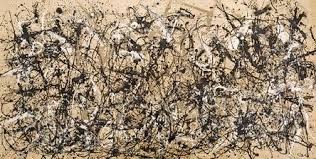
1 note
·
View note